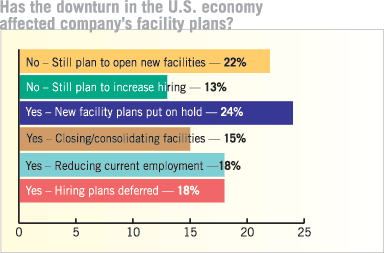23rd Annual Corporate Survey Analysis by Ed McCallum
Dec/Jan 09

In spite of the recent volatility in the marketplace, there has not been a corresponding overreaction or concern regarding costs. Then again, perhaps there should be an overreaction.
In a cost-conscious environment, both energy availability and costs and labor costs would typically be of major issue; however, oddly enough, concern about these factors decreased by 1.1 and 0.9 percentage points, respectively. Is this sentiment sensible given that both energy and labor costs will certainly increase - that is if history teaches us anything? I would say that it is in some ways.
There is a greater concern over training programs and proximity to technical university, both of which increased by 5.7 percentage points. This speaks volumes about the where the focus should be in order to increase competitiveness in the marketplace. It begs the reader to ask the obvious question, "Is there enough concern?" Personally, I do not think there is regarding either energy costs or worker training.
Two dramatic statistics in the survey are the increased concern for the availability of healthcare facilities (which went up more than 20 percentage points) and the decreased concern for railroad service (which declined by almost 11 percentage points), although neither of these ratings should be surprising. One only has to examine the current demographic statistics on aging to understand why healthcare is an increasingly important component of work force recruitment and retention. I suspect this will be a continuing concern for a long time.
Regarding the decreased concern for railroad service, there has been a dramatic slowdown in very large capital investments, which typically are the exact industries that require rail. Of greater significance is the lack of concern over the economies associated with rail transport and the inevitable increase in energy costs on a transportation system that is way overtaxed. This is a mistake in a time when industry should be driving policymakers to correct this inadequacy.
Project Announcements
Eurofins Lancaster Laboratories Expands Lancaster County, Pennsylvania, Research Operations
01/03/2026
Creative 3D Technologies Expands Cedar Park, Texas, Headquarters-Manufacturing Operations
01/03/2026
Valerie Health Plans Chattanooga, Tennessee, Operations
01/02/2026
Samsung Biologics Plans Rockville, Maryland, Manufacturing Operations
12/31/2025
Kraken Technologies Limited Plans New York City Headquarters Operations
12/29/2025
Lupin Expands Coral Springs, Florida, Operations
12/29/2025
Most Read
-
The Workforce Bottleneck in America’s Manufacturing Revival
Q4 2025
-
Rethinking Local Governments Through Consolidation and Choice
Q3 2025
-
Data Centers in 2025: When Power Became the Gatekeeper
Q4 2025
-
Tariff Shockwaves Hit the Industrial Sector
Q4 2025
-
Investors Seek Shelter in Food-Focused Real Estate
Q3 2025
-
The Permit Puzzle and the Path to Groundbreaking
Q3 2025
-
Supply Chain Whiplash Reshapes CRE
Q3 2025

